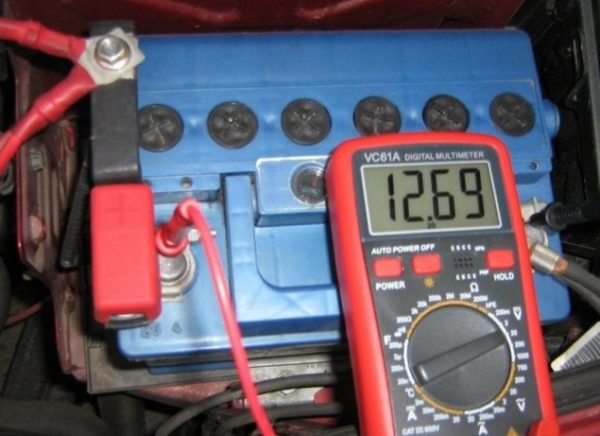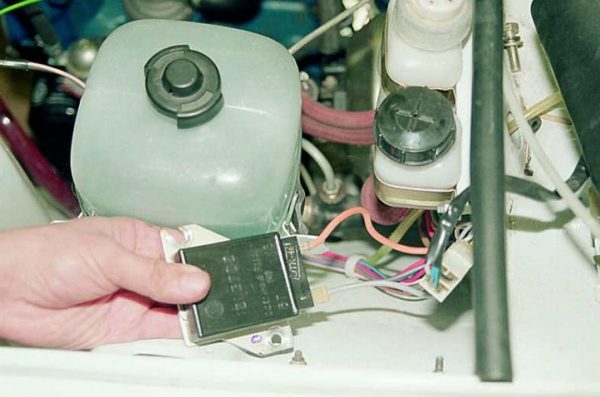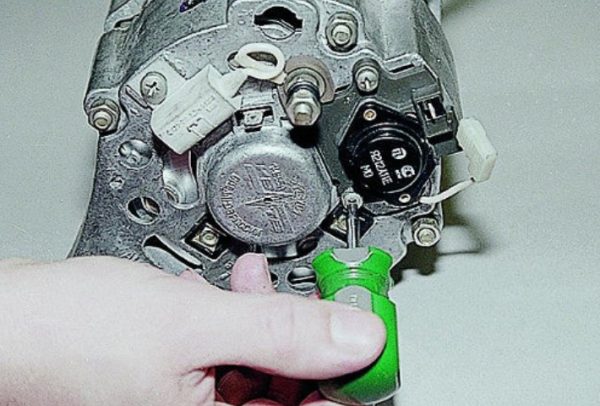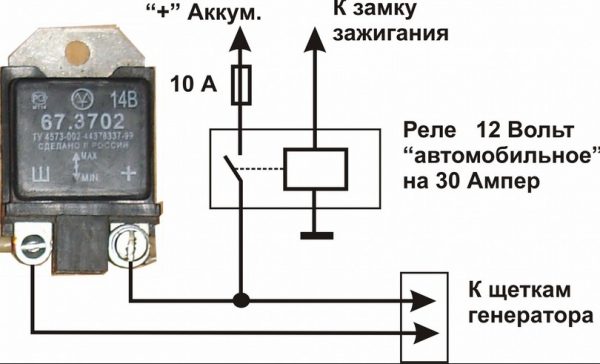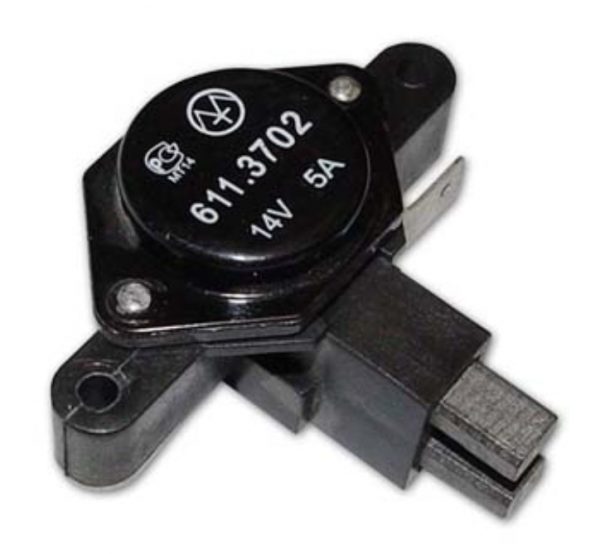
We independently check the generator voltage regulator on the VAZ 2107
Content
Sometimes the VAZ 2107 battery for some reason stops charging, or it charges very weakly. Having gone through a lot of options, the car owner sooner or later gets to the voltage regulator on the VAZ 2107 generator. Is it possible to check the serviceability of this device without contacting a car service? Can! Let's try to figure out how it's done.
Purpose of the voltage regulator
The purpose of the voltage regulator is easy to guess from the name of this device. The task of the regulator is to maintain the strength of the current coming from the generator at such a level that the voltage generated by the same generator is always kept within the specified limits.

More about the VAZ 2107 generator: https://bumper.guru/klassicheskie-modeli-vaz/generator/remont-generatora-vaz-2107.html
However, it should not depend on the speed of rotation of the generator. And the current consumed by the car should also not affect the voltage created by the car generator. For the implementation of all these tasks on a VAZ 2107 car, the generator voltage regulator is responsible.
Varieties and location of voltage regulators
As you know, the VAZ 2107 car began to be produced a very long time ago. And in different years, not only different engines were installed on it, but also different voltage regulators. On the earliest models, the relay-regulators were external. On later "sevens" regulators were internal three-level. Let's take a closer look at these devices.
External voltage regulator VAZ 2107
It is the external voltage regulator that many motorists call the "relay-regulator" in the old fashioned way. Today, external voltage regulators can only be seen on very old "sevens" produced before 1995. On these cars, an old model 37.3701 generator was installed, which was equipped with external relays.
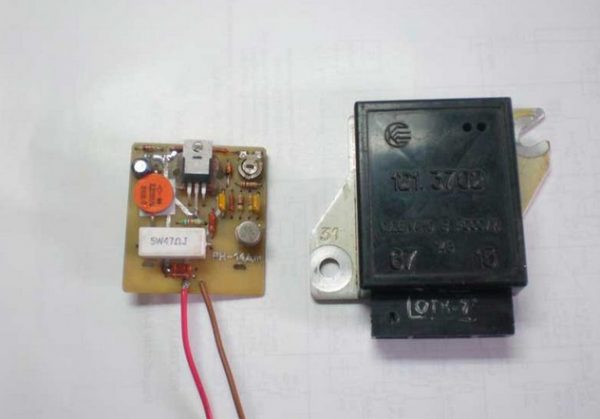
The external regulator was located under the hood of the car, it was attached to the left front wheel arch of the car. As a rule, external relays were made on the basis of a single semiconductor, although after 1998 on some VAZ 2107 there were external regulators made on a common printed circuit board.
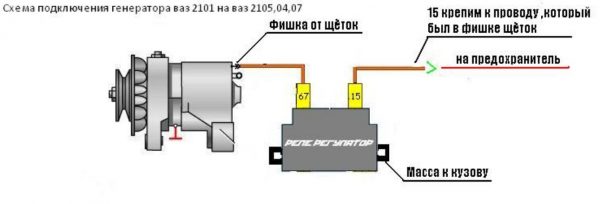
External relays had certain advantages:
- replacing the external regulator was easy enough. It was held on by only two bolts, which were easy to get to. The only mistake that a beginner could make when replacing this device was to interchange terminals 15 and 67 (they are located side by side on the regulator);
- the cost of an external regulator was quite affordable, and they were sold in almost all car dealerships.
Of course, the device also had disadvantages:
- cumbersome construction. Compared to later electronic regulators, the external relay seems to be very large and takes up too much engine compartment;
- low reliability. External VAZ regulators have never been of high quality. It is difficult to say what is the reason for this: the low quality of individual components or the poor build quality of the device itself. But the fact remains.
Internal three-level voltage regulator
Internal three-level voltage regulators have been installed on the VAZ 2107 since 1999.

These compact electronic devices were built directly into car alternators.

This technical solution had its advantages:
- compact dimensions. Electronics replaced semiconductors, so now the voltage regulator fit in the palm of your hand;
- reliability. It's simple: there is nothing special to break in electronic devices. The only reason why a three-level regulator could burn out is a short circuit in the on-board network.
There are also disadvantages:
- difficulty of replacement. If there were no particular problems with external regulators, then to replace the internal relay, the car owner first needs to get to the generator. To do this, he will have to remove the air filter and a couple of air ducts, which requires patience and time;
- acquisition difficulty. As you know, the VAZ 2107 has long been discontinued. So it becomes more and more difficult to get new components for the "seven" every year. Of course, this rule does not apply to all details. But the internal three-level voltage regulators for the VAZ 2107 are just among the parts that are not so easy to find today.
Read about malfunctions of the VAZ 2107 generator: https://bumper.guru/klassicheskie-modeli-vaz/generator/proverka-generatora-vaz-2107.html
Dismantling and testing voltage regulators on the VAZ 2107
First, let's decide on the tools and devices that will be required for the job. Here they are:
- household multimeter;
- open-end wrench for 10;
- flat screwdriver;
- Phillips screwdriver.
Sequence of work
If the driver has suspicions about the breakdown of the voltage regulator, then the first thing he should do is check the voltage supplied by the battery.
- The car's engine is turned off and the hood opens. Using a multimeter, measure the voltage between the battery terminals. If it falls below 13 volts (or vice versa, it rises above 14 volts), then this indicates a breakdown of the regulator.
 If the regulator breaks down, the first thing to check is the voltage between the battery terminals.
If the regulator breaks down, the first thing to check is the voltage between the battery terminals. - After making sure that the battery is not charging well precisely because of a faulty regulator, it must be disconnected from the car's network, but first, the ground wire must be removed from the battery. If this wire is not disconnected, then there is a high probability of a short circuit, which will lead not only to the burnout of many fuses in the closed section, but also to the melting of the electrical wiring itself.
- If an old external regulator is installed on the VAZ 2107, then all the terminals are manually removed from it, after which the nuts that hold the regulator on the car body are unscrewed with an open-end wrench for 10.
 The external voltage regulator VAZ 2107 rests on only two 10 bolts
The external voltage regulator VAZ 2107 rests on only two 10 bolts - If the VAZ 2107 is equipped with an internal three-level regulator, then to remove it, you will need to unscrew a pair of mounting bolts holding this device in the generator housing with a Phillips screwdriver.
 The internal regulator is removed using a small Phillips screwdriver.
The internal regulator is removed using a small Phillips screwdriver. - After removing the regulator, the negative pole of the battery is connected to the relay ground (if the regulator is external), or to the “Sh” contact (if the regulator is internal);
 Contact "Sh" is located in the lower left corner of the voltage regulator
Contact "Sh" is located in the lower left corner of the voltage regulator - The positive pole of the battery is connected to the "K" contact (this contact is available on all types of regulators);
- The multimeter is connected either to the generator brushes or to the relay outputs.
- After turning on the multimeter and applying a voltage of 12–15 volts, it should also appear on the generator brushes (or at the relay outputs, if the regulator is external). If the voltage that has arisen on the brushes or at the outputs is kept constant, then this is a clear sign of a breakdown of the regulator. If no voltage is recorded on the brushes or outputs at all, there is an open in the regulator.
- Both in the event of a breakdown and in the event of a break, the regulator will have to be changed, since this device cannot be repaired.
- The failed regulator is replaced with a new one, after which the vehicle's electrical system is reassembled.
Learn more about the VAZ 2107 battery: https://bumper.guru/klassicheskie-modeli-vaz/elektrooborudovanie/kakoy-akkumulyator-luchshe-dlya-avtomobilya-vaz-2107.html
Video: check the voltage regulator on the VAZ 2107
So, even a novice motorist can check the voltage regulator on the VAZ 2107. All it takes is the ability to use a multimeter and a screwdriver. The implementation of the above recommendations will allow the car owner to save about 500 rubles. This is how much it costs in a car service to check and replace the voltage regulator.


